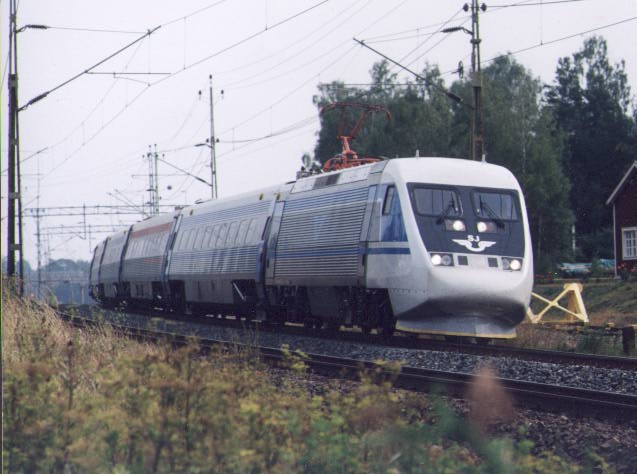Try Transit for a Better Future
your guide to rail transit in the US and worldwide

Sweden's beautiful X2000 photographed by Urban Fredriksson (griffon@kuai.se)
Railroad trains are hands-down the most efficient way for getting around on land. After World War II, however, we in the USA began an orgy of insanity that cost us thousands of miles of track. Hindsight has proven to be 20/20 again but now we are stuck with the most wasteful, expensive, and polluting infrastructure around.Americans had sought to have the automobile replace all other forms of transportation, even, to a large degree, walking. (How much is in walking distance in a post-WWII development, and what about all those drive-thru's?) Never mind the fact that 2 tracks can carry as much as 16 lanes of highway (and which would you rather have run through the middle of your neighborhood?), every few weeks we receive reports of negative consequences that our car-centric culture is bringing upon us. To name a few of the most recent: the "road rage" phenomenon (I'd be pissed too if I had to waste my life just sitting in stop-and-go traffic.), life-shortening microparticles in the air (produced by internal combustion engines) that lodge in the lungs, slowly tearing them up, and impediments to welfare reform (jobs are being lured to areas where there is no public transportation for those who cannot afford a car). Our dependence on foreign oil (used mainly to fuel our gasoline binge) continues to threaten our national security and destabilize the geopolitical situation.
Every road built adds to the tax burden via interest on construction bonds and expenses for cleaning, snow, ice, and water removal, policing, and maintenance. I personally replaced rail on Conrail's Boston and Albany line that was over 50 years old. That line carried extremely heavy traffic, including long, massive doublestack trains. How many busy roads can last half that long without major repaving and resurfacing?
The enormity of the damage inflicted on the natural environment and human society by the car culture cannot be underestimated. Take your first bold steps away from that four-wheeled steel-and-plastic prison and try the train. To make your quest even easier I have provided this page of transit links. I have concentrated on the USA because that's where the problem is worst, but I will add more international links as I become familiar with them. Once on the train you can read the newspaper, talk to a friend (or a stranger), use a laptop computer, take a nap, or even use your cellphone (quietly) without risking life or limb. You'll wonder how you ever put up with red lights, fumes, and sharking for parking.
Amtrak (USA Intercity)
New York City (and Long Island, Western Conneticut, Southeast New York State)
Eastern Conneticut
New Jersey
PATH Newark/Hoboken/NYC
Syracuse, New York
Buffalo, New York
Boston
Philadelphia
Philadelphia-Lindenwold, NJ Hi-Speed
Pittsburgh
Baltimore
Washington, DC
Virginia
Memphis, TN
Atlanta
Miami Downtown
Miami/South Florida Area
Chicago Downtown
Chicago Area
Chicago-Northern Indiana
Denver
St. Louis
Dallas
Portland, OR
Sacramento, CA
San Francisco Downtown
San Francisco Area
Stockton / San Jose
San Jose / Santa Clara Valley
Los Angeles
San Diego Trolley
San Diego Coaster
Southern California
California Caltrain
Alaska
Canada Intercity
Toronto, Canada
Ontario, Canada
British Columbia, Canada
Vancouver, Canada
France Intercity
Sweden Intercity
UK (Britian) Intercity
European Intercity
International Subway Locator
This is a work in progress.
To learn more about modern railroading and railroad history, go to:
Rayden Tron's Railroad Resource Center

Rayden Tron's Homepage | Rayden Tron's Railroad Resource Center